Owners and winemakers of their family estate in Roussillon: “In their finesse and their personality our wines are like women”.
For the 28th interview in Le Figaro Vin’s series we pay our first visit to Roussillon to meet the Danjou brothers, Benoît and Sébastien, #24. Domaine Danjou-Banessy, in Espira-de-l’Agly, is poetically situated between the precipitous slopes of the Pyrenees and the foothills of the Corbières. The estate is home to several generations of vines between 15 and 120 years old, spread over a mosaic of soils that put the Climats of Burgundy in the shade.

This is a family history that has skipped a generation. Artisans and farmers in their souls, Benoît and Sébastien Danjou joined forces to take over their grandfather’s 32 hectares of vines, surrounded by 20 hectares of woodland, forest, and moor. As Sébastien made clear, although their grandfather had always treated the land and nature with respect, “the estate was showing signs of serious neglect”. For all the charm of its hundred-year-old vines, their productivity had steadily declined. “We have kept the old vines in good condition,” added Sébastien, “while cutting out all forms of aggressive intervention”. Now certified organic, and cultivating an area reduced to 20 hectares, the two brothers produce magnificent Grenaches, Carignans, Muscats, and other southern grape varieties, and remain unwavering in their refusal to rest on their laurels. They are two of the most talented winemakers in Roussillon.
Le Figaro Vin: How does it feel to be crowned a winemaking champion?
Sébastien and Benoît Danjou: We are delighted, but being champions is not core to our philosophy. We don’t want to be famous, we just want recognition, above all from our peers. We are not looking to make the best wine in the world.
What is your greatest source of pride?
To have managed to carry on working in the simplest way possible, with the mindset of artisans and peasants. The latter were looked down on, unjustifiably, and we are determined to stick with this approach, working exclusively with what we produce on the estate, without buying any grapes in.
Have you been training for long?
Since childhood. We haven’t had any academic training. And we know that an entire lifetime of training isn’t enough – there is always something new to learn.
Who is your mentor?
Surprisingly we have never had one. We spent ten years overhauling a family estate and never had the time to check out what was going on around us, either locally or further afield. Without a mentor, we had to learn from our mistakes. Since we became established we have opened our minds through a number of visits to estates where we have found common ground or, conversely, fundamental differences in approach.
Is wine a team sport?
Absolutely. Our team is very small but essential.
What is the key to making a good wine? The terroir or the winemaker?
The terroir, without any reservation, and we try to express it as precisely as we can.
To what do you owe your success?
To numerous encounters which have helped spread the word about our wines. We are regularly classified in the natural wine category, although we don’t claim any affiliation. We do feel a connection to it, but it’s become a kind of compartment, with an increasingly fuzzy definition, in which we feel less and less at home. It’s true that natural wines are proliferating, and that’s a good thing, but plenty end up down the drain!
Is your family proud of you?
Yes, although none of them would ever say so.
Your favourite colour?
Let’s say not too white, as that suggests the need for clarification, and not too red, as that indicates excessive extraction.
Your favourite grape variety?
Carignan, which is a grape variety for the future and one that has been widely disparaged for its rusticity. It has just been poorly understood. Carignan is a late variety, well-adapted to climate change. We would agree that it is hardy, from a physiological perspective, but it has a lovely acidity. It’s the Roussillon grape variety that deserves wider recognition, whether as Carignan Blanc, Gris, or Noir.
Your favourite wine?
For me (Sébastien, ed.) it’s Estaca, and for my brother Espurna. We are deeply attached to all our wines, but these two are made from very old vines and we feel indebted to those who worked them before us. They have been through more than 100 prunings and we are full of admiration and respect for their longevity.
Your favourite vintage?
2020, a really complete vintage.
If your wine was a person, who would it be?
We hope that our wine resembles Roussillon, and we are always saying that in their finesse and their personality, our wines are like women. They don’t parade their muscles; they aren’t show animals with broad shoulders!
What are the best circumstances in which to taste your wine?
In company, in any number of situations. A friend likes to tell us that there are no great wines, just great bottles. A bottle is always the coming together of a time, a place, and people, whether previously acquainted or not.
Who is your strongest competition?
This year we have had quite a struggle with the climate, but we have a great deal of respect for it.
Which competition do you fear the most?
We have some problems with water, especially in the summer of course, but no particular time is really more testing than others. Here in the south we are not afraid of summer drought.
For what price would you be prepared to sell your estate?
We couldn’t put a price on it. We appreciate, nevertheless, that vineyards are subject to major speculation. However, that is not such a bad thing since it’s reassuring to know that our work has a tangible value, even if the speculation sometimes verges on the ridiculous.
What is your greatest trophy?
We still have plenty of room to improve. We are satisfied but never complacent. That’s what drives us on a daily basis.
Who would be your ideal successor on the podium?
We would be happy for our children to take over, but they are still young. This job is a true vocation, and we are not going to push them. We would like them to share the same values. Passing the baton is something fundamental and we won’t indulge in hypotheticals. Winegrowing is transgenerational and we have to accept that each generation will have a different way of doing things, but we would like to hand the estate on to people who have truly understood our work.
Owner and winemaker of his family estate in Bandol: “I was regarded as the ‘son of’ for a very long time”.
The 22nd interview in Le Figaro Vin’s series finds us once more in Provence, at Château de Pibarnon, a southern jewel which has been raising the profile of the Bandol wine region for nearly half a century. We are here to meet Éric de Saint-Victor, #29, a second-generation owner who, after many years in the shadow of his parents, has firmly established his place at the zenith of the appellation.
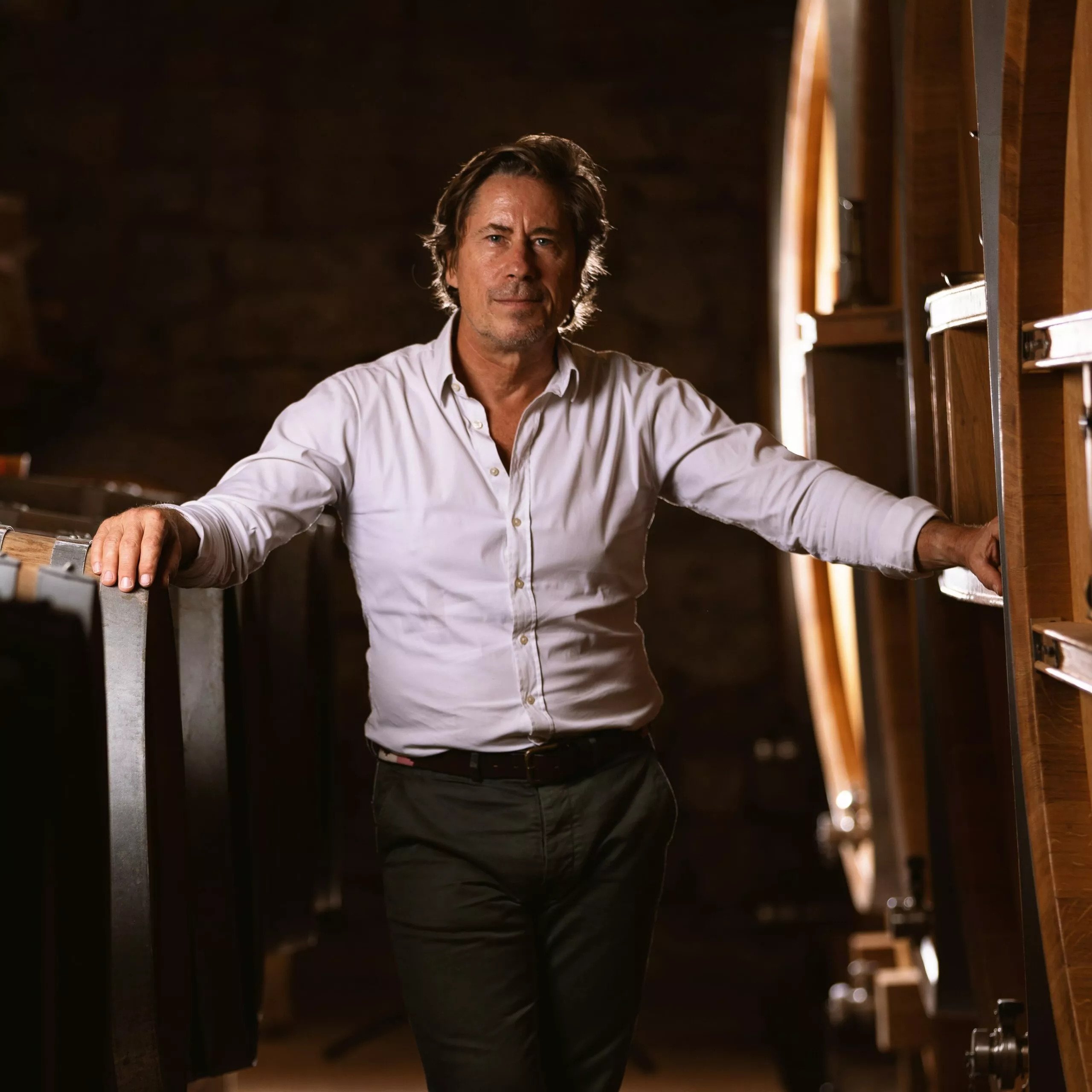
With a mere three hectares acquired in 1977, in an appellation which formerly struggled to get on the map, Château de Pibarnon began life as a genuine gamble. “My parents purchased what was within their means,” acknowledges Éric de Saint-Victor. “My father saw that you could do something extraordinary in Bandol. They created everything from scratch.” With its two red wines, two rosés, and one white, the estate now ranks among the most sought-after in France and plays a major part in the growing reputation of the Bandol wine region on both national and international stages.
Le Figaro Vin: How does it feel to be crowned a winemaking champion?
Éric de Saint-Victor: It reminds me of something my father used to say when he heard himself described as the best: “I am one of the two best, but we don’t know who the other one is!” We should bear in mind that in the 1980s and 1990s there was a competitive atmosphere between the estates, who were in a race to get results and win attention. A great wine had to be powerful and intense. That was the norm, especially in Bandol. When it comes to me, I am really fortunate to have had the time to develop my expertise and to benefit from well-established vines, so today, above all, the challenge is with myself, in the pursuit of craftsmanship rather than competition. It makes me very happy to be regarded as a champion, but just like with sailing, you have to put your own boat in order before taking on others.
Have you been training for long?
At the outset I learnt alongside my parents. My father taught me about winemaking, my mother about the business side of things. The training never stops, and you are always taking risks.
Who is your mentor?
Alain Brumont (of Château Montus and Château Bouscassé in the Southwest, ed.) who visited the estate in 1989. He was the first winemaker of note to treat me as an equal. I was regarded as the “son of” for a very long time, whereas he spoke to me as one winemaker to another, which boosted my confidence. I think that more than having a mentor, what is really valuable is to analyse the pathways taken by winemakers whose wines you love and to see how these can be understood through their wines. In this respect tasting is key to analysis. I always say that Pibarnon’s first customer is me!
Is wine a team sport?
Of course. We have a talented team here and the working atmosphere is pivotal. I don’t want a team of pruning shears; I want human beings. Everyone brings something to the table, and I favour consensus and collective decision-making.
What is the key to making a good wine? The terroir or the winemaker?
We are merely part of the terroir, it is our job to give it meaning, to interpret it, whereas the substrate is immutable.
To what do you owe your success?
First and foremost to the terroir. Here in Bandol we have a unique geological layer, a Triassic limestone soil which is exceptional, enjoys excellent hydromorphology, and produces grapes with quite intense tannins.
Is your family proud of you?
I think so, even though I have been an “orphan” since the ages of 49 and 50.
Your favourite colour?
I like white, although it’s hard to choose. I roll with the seasons. My favourite style of wine is the one that takes me into its own world. I don’t look to be amazed, I go for depth and the experience of discovery.
Your favourite grape variety?
Mourvèdre, which has a fascinating, very romantic character. It’s a Don Quixote, untamed and freethinking. It’s a grape variety that requires freedom, it’s not a circus animal: you can’t put it in a box, you have to know how to guide it.
Your favourite wine?
Because of my genes it has to be Le Rouge du Château, which is Pibarnon’s standard bearer, combining all the attributes of the estate. In our southernmost environment we contrive to produce something fresh, which makes for an astonishing paradox on the palate. These are wines of light rather than wines of heat.
Your favourite vintage?
No vintage is exactly like another. I really liked 2019, for which we went out on a limb.
If your wine was a person, who would it be?
A character from fiction, but intellectually rich, a bit like Steve McQueen with a feline side. It’s a wine that sometimes shows its claws but has a smooth and solitary side.
What are the best circumstances in which to taste your wine?
When the wines are young, over a meal, when they have aged, in a more contemplative way, especially after 25 years of ageing. The latter are more meditative wines, producing more heightened states of intoxication, whereas the former make the conversation flow.
Who is your strongest competition?
Drought.
What is your greatest trophy?
My father won six gold medals at the Concours Général Agricole de Paris. He exuded a special charm and had built up some very strong relationships with sommeliers and winemakers. In 1993 I began to take over responsibility for winemaking, then, a few years after that, I entered a competition in England. I gave that a shot because in France I would have been afraid of only getting bronze! Neither Bandol wines nor Mourvèdre were specified on the entry form, so I competed in the “others” category and six weeks later I was awarded a prize. This story aside, the greatest trophy for me today is to share a tasting with a great sommelier and to see in his eyes a growing understanding which reveals a sense of experiencing something new.
Who would be your ideal successor on the podium?
Someone who could take my place while showing true independence through their own take on things. Someone who could build on their experience on the estate and find their own voice: they would be the ideal successor.
Winemaker of this revered estate in Pommard: “I’m a bit of a junkyard dog!”.
The 21st interview in Le Figaro Vin’s series finds us on our third visit to Burgundy to meet Paul Zinetti, #30. Burgundian by birth, he joined Domaine du Comte Armand, among the most iconic Côte-d’Or estates, in 2010, and took over the winemaking reins from Benjamin Leroux in 2014. Today he cultivates nine hectares of vines in Pommard, where the estate is based, together with vineyard plots in Volnay and Auxey-Duresses.
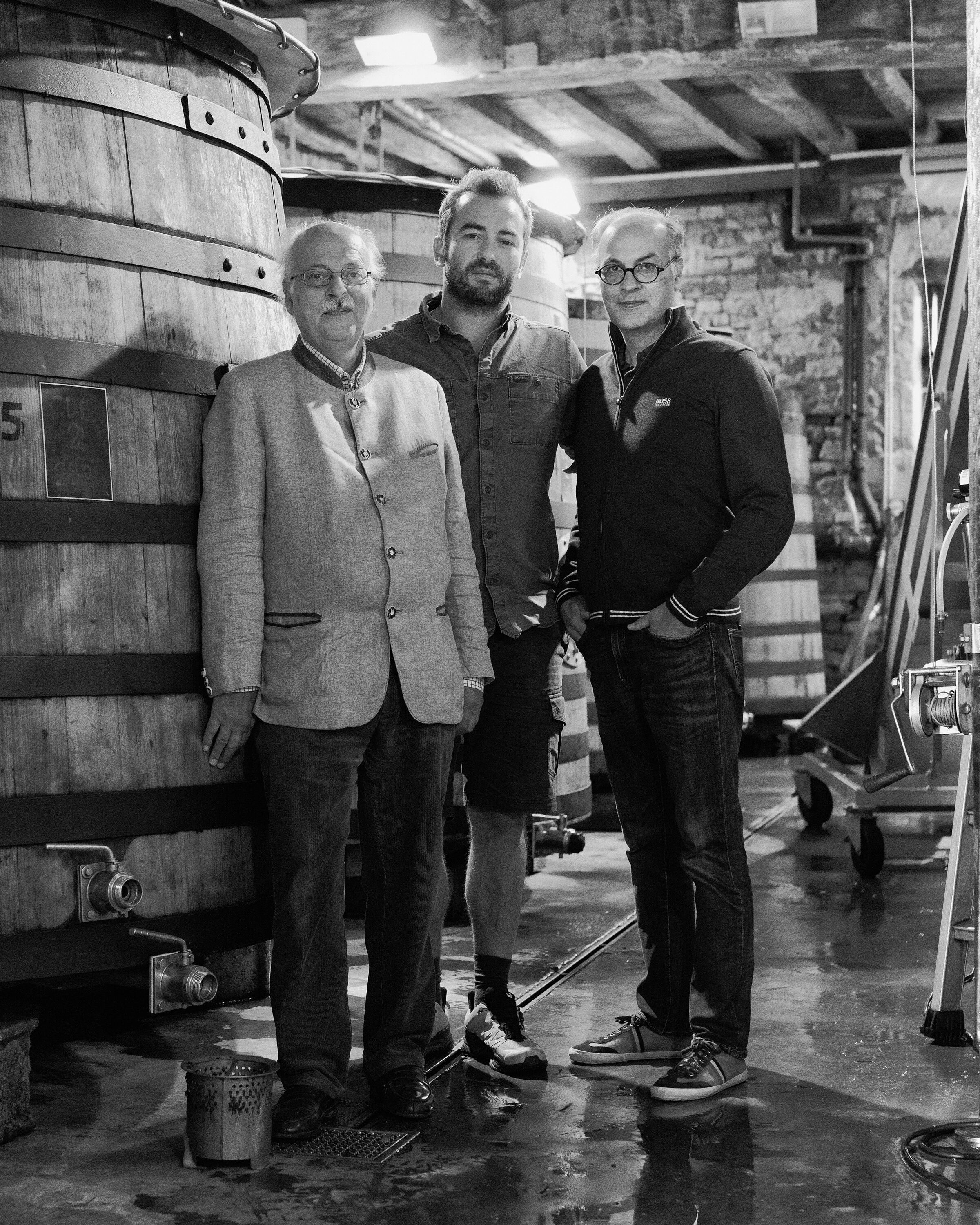
Paul Zinetti is forthright and unconcerned with social niceties. As a manager who is not an owner – a rarity in Burgundy – he laughingly admits to his lack of formal qualifications, being neither an oenologist nor even the holder of a technical diploma. “I’m a bit of a junkyard dog!”, declares the forty-year-old in a deliberately provocative manner. Yet, you can feel his extraordinary sensitivity, his capacity to observe and interpret a terroir whose nature changes with the passing years, which allows him to produce wines of exceptional finesse from every vintage.
Le Figaro Vin: How does it feel to be crowned a winemaking champion?
Paul Zinetti: It makes me happy, but I will be humble about it as I have never set much store by awards.
Have you been training for long?
Since I was 18. I spent five years in Languedoc, then I came back up to Mâconnais, before landing in Côte-d’Or.
Who is your mentor?
Dominique Lafon, in Mersault, and his brother Bruno in Languedoc. I have built up my know-how by learning from a number of winemakers, but those are the two who have really inspired me.
Is wine a team sport?
Yes, I’m a bit like the captain of the ship, and my team follows me.
What is the key to making a good wine? The terroir or the winemaker?
Both of them. I depend on the terroir, but I try to give it the best possible interpretation through my wines. Terroir and winemaker must go hand in hand. Great terroirs give you an advantage, but you have to know how to handle them, how to tame them. You will never be able to make great wines from poor terroir, although I appreciate that global warming means you can make good wines pretty much everywhere.
To what do you owe your success?
To myself.
Is your family proud of you?
A little bit, I think. They are happy rather than proud. These are things that remain unspoken.
Your favourite colour?
Red for wine, otherwise green.
Your favourite grape variety?
Pinot Noir, which is sensitive and refined.
Your favourite wine?
Le Grand Rouge from Revelette, for sentimental reasons.
Your favourite vintage?
2015, which I believe will turn out to be a great vintage.
If your wine was a person, who would it be?
It would be a Scorpio, which is my astrological sign. With my wines it’s a case of “all or nothing”, as they say. They are full-on wines.
What are the best circumstances in which to taste your wine?
Among friends.
Have you ever thought about chemically enhancing yourself, or your wine?
Personally never, but I did adulterate my wine when I was young. That said, red wine is an excellent stimulant. We should remember that they used to drink red wine on the Tour de France back in the 1920s.
Who is your strongest competition?
Myself, first and foremost.
Which competition do you dread the most?
The seasons of pruning and harvesting, namely spring and summer.
What is your greatest trophy?
My children.
What has been your most innovative strategy in the vineyard and in the cellar?
Constant observation and questioning everything. What was true five years ago is by no means necessarily true today.
Who would be your ideal successor on the podium?
Raphaële Tinoco, a young woman already on our estate team, who I hope will take over one day.
Co-owner and winemaker of Château Beauséjour Duffau-Lagarrosse: “I do not believe that the land belongs to us”.
The 20th interview in Le Figaro Vin’s series takes us back to Bordeaux, where Joséphine Duffau-Lagarrosse, #31, maintains her family legacy at Château Beauséjour, Premier Grand Cru Classé B de Saint-Émilion. With her impressive maturity and depth of insight, she ranks among the most talented winemakers of her generation.
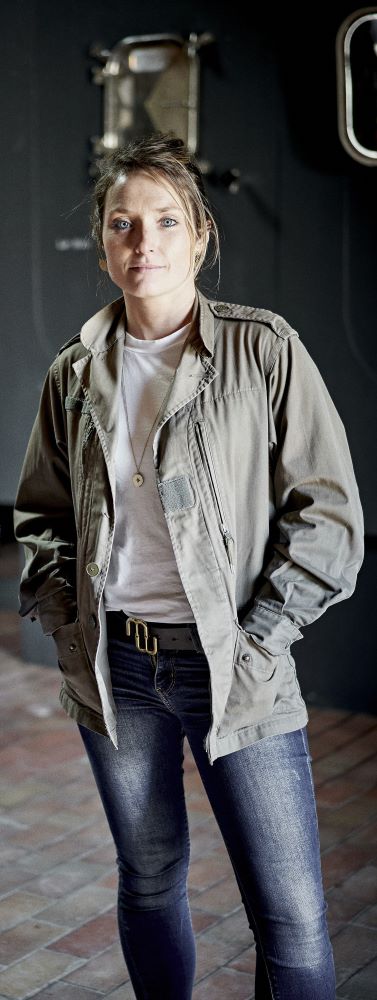
Her seven-hectare estate, in the iconic Right Bank appellation of Saint-Émilion, boasts an exceptional limestone plateau terroir. The vineyard is planted with rows of Merlot and of Cabernet Franc, which produce wines of extraordinary vivacity.
Having been passed down the generations since 1847, Château Beauséjour underwent a tumultuous sale in 2021. It now belongs jointly to Joséphine Duffau-Lagarrosse, 33 – the last of the family remaining at the Château – and Prisca Courtin, 35, granddaughter of Jacques Courtin, founder of Clarins. Joséphine draws to good effect on her ten years’ experience on estates ranging from Burgundy to Mexico, by way of New Zealand, and finally to Bordeaux, notably with Bernard Magrez. Today she oversees the production of her estate’s wines with great panache, supported by two renowned consultant oenologists, Axel Marchal and Julien Viaud.
Le Figaro Vin: How does it feel to be crowned a winemaking champion?
Joséphine Duffau-Lagarrosse: If that is how you regard me, then I feel a degree of pride!
Have you been training for long?
Yes, for quite some time. My grandparents on both sides were great wine connoisseurs. They were a formative influence from my earliest years and had me tasting well before I came of age. I have deep aromatic memories that underpin my keen sense of smell and taste. My nose has been practising for a long time. As far as vinification is concerned, there is only one vintage per year, and each one is different. We always tell ourselves that we will do things differently next time. So every year involves further training.
Who is your mentor?
Axel Marchal and Julien Viaud (who embody the new generation of consultant-oenologists in Bordeaux, ed.) are part of my team. They challenge me but their job is not, strictly speaking, to mentor me. I would suggest, rather, that nature is our mentor. From one year to the next, we have to aim higher.
Is wine a team sport?
Yes, very clearly, because wine starts with the vines, and I am not on my own in the vineyard. Some members of my team have been at Beauséjour for 30 years, and without them – Izilda and Christophe – it would be difficult. They bring their own insights and their deep familiarity with the property. To give some context, Izilda’s parents were originally hired by my great-grandparents. As for the vinification, I have Axel Marchal, Julien Viaud, and Camille de Villenaut to support me. We challenge each other and move forward as a team!
What is the key to making a good wine? The terroir or the winemaker?
That’s a really tricky question. When you have a great terroir, if the winemaker makes a mistake, in terms, it is the terroir that can rectify the situation. On the other hand, a good winemaker might make something fantastic from a poor terroir. But, if I have to decide, the terroir comes out on top.
To what do you owe your success?
It’s partly a question of upbringing, which I owe to my family. They taught me the value of the land and of hard work. As for the success of Beauséjour, that is down to meeting Prisca (Courtin, President of the Clarins Group’s Oversight Committee, ed.) who believed in our project. My upbringing has enabled me to follow through on our acquisition, and to persevere in the face of stressful conditions.
Are your parents proud of you? And is your dog?
Yes, I think so. My dog Tokaj is too, and happy to spend every day here at Beauséjour.
Who is your biggest supporter?
Prisca Courtin.
Your favourite colour?
Blue.
Your favourite grape variety?
Cabernet Franc.
Your favourite wine?
I love Domaine de Vaccelli’s Granit. It is the wine which, in a blind tasting, I always place in Burgundy, even though it’s from Corsica!
Your favourite vintage?
1990 (the Beauséjour vintage which has acquired legendary status and the year that Joséphine was born, ed.).
If your wine was a person, who would it be?
Someone with quiet strength who opens up over time.
What are the best circumstances in which to taste your wine?
Over a good meal, with a delicious piece of meat, and with friends.
Have you ever thought about chemically enhancing yourself, or your wine?
Never.
For what price would you be prepared to sell your estate?
I do not believe that the land belongs to us. My grandfather used to say – and my father would repeat it – men pass through while the terroir remains. I cannot sell what isn’t mine. So I will never sell, not for any price.
Who is your strongest competition in Saint-Émilion?
That’s rather a loaded question. We are often told that we are the next Ausone. In terms of terroir, I believe that to be true.
Which competition do you dread the most?
I don’t feel as though we are in a competition with our neighbours. If all the Saint-Émilion Grands Crus perform, that has an international reach. I don’t have the competitive streak. Contrary to what people might think, we do not compete with each other in Saint-Émilion, we compete for our appellation’s international ranking. I check out the ratings of my neighbours’ wines, of course, but you have to behave in the right way. If our neighbours, like Bécot, Canon, Angélus etc., were to come to us tomorrow asking to borrow some equipment, then of course we would help them out.
What are you most proud of?
The revival of Beauséjour.
What has been your most innovative strategy in the vineyard and in the cellar?
There have been technical innovations, of course, but I feel there has been a return to common sense. My most innovative strategy has been to refocus on observation and intuition. We have gone through a phase which has brought in a mass of technology, like measuring probes, and infrared. We have also learnt that innovation is not the answer to everything. We need to get back to the basics.
Who would be your ideal successor on the podium?
It would be someone with common sense, humility, and an open mind.
Owner of his family estate in Corsica and winemaker: “I was never any good as a conventional winemaker!”
The 17th interview in Le Figaro Vin’s series finds us in southern Corsica, where the luxuriant plots of Domaine Comte Abbatucci lie nestled in the heart of the Taravo Valley. We are here to meet Jean-Charles Abbatucci, #34, the island’s undisputed champion of biodynamic viticulture.
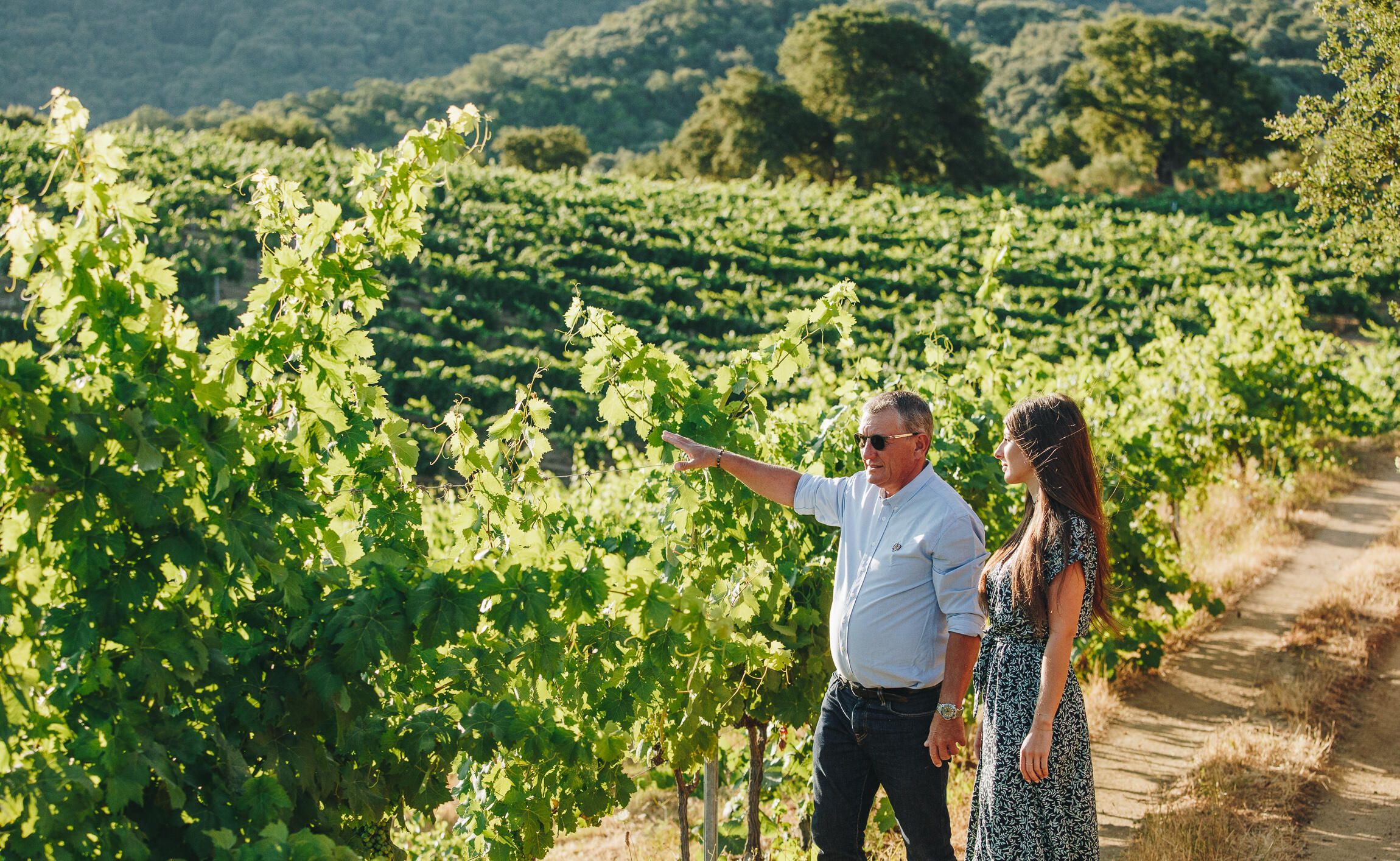
Domaine Comte Abbatucci is a living ampelographic museum of the Corsican wine region, with no fewer than 18 grape varieties grown alongside each other. With his hat firmly in place, and a pair of sunglasses hiding the twinkle in his eyes, the legendary winemaker that is Jean-Charles Abbatucci has acquired, over the course of many vintages, an encyclopaedic knowledge of all aspects of biodynamic viticulture. This knowledge extends from its history to its philosophy, with a dash of the esoteric.
While he describes himself as a pragmatist, he is constantly trying out new approaches, the most striking of which remains the treatment of vines with seawater. In the cellar, the wines range from those bearing the stamp of an outmoded nobility, from Ministre Impérial to Général de la Révolution, through to the cuvée named Faustine, after his daughter, available as a red, a white, and a rosé. Now a member of the Académie du vin de France, Jean-Charles Abbatucci embodies both the memory and the future of Corsican winegrowing.
Le Figaro Vin: How does it feel to be crowned a winemaking champion?
Jean-Charles Abbatucci: In my opinion being a champion is, above all, about giving expression to your terroir and to your grape varieties. It’s a particular vision of agriculture and the winemaker’s vocation.
Have you been training for long?
Yes, for 30 years now. When I started out, I was pretty conventional, doing what I could with the means at my disposal. But I was never any good as a conventional winemaker! One day, after ten years, something just clicked. This brought about my transition to organic and biodynamic agriculture, and the results of that transformation are what have made me a champion.
Who is your mentor?
From the 2000s onwards my mentor has been nature. When you take a step in her direction, she takes ten towards you. She can be capricious, admittedly, but then we are too. You have to be able to deal with that, assess the situation, and challenge yourself.
Is wine a team sport?
Yes, of course. The more you are a champion, the more you need a strong support team. Ultimately it is the athlete or the winemaker that lifts the trophy, but, behind the scenes, the winemaker benefits from the different perspectives that can be provided by an oenologist, a vineyard manager, etc.
What is the key to making a good wine? The terroir or the winemaker?
It is all of them together. I believe that there is an alchemy between the terroir, the winemaker, and nature.
To what do you owe your success?
In my case, to my father who was responsible for the preservation of the historic Corsican grape varieties. If he hadn’t been inspired to collect them, I wouldn’t be where I am today. But I must also acknowledge that I am fortunate to enjoy an exceptional terroir and a wonderful island.
Is your family proud of you?
Yes, they are all very proud. I have a very close working relationship with my brothers, one of whom is a restaurateur, the other a farmer. We are always bouncing ideas around.
Who is your biggest supporter?
It has to be nature, yet again. She gives me everything, not least the traditional Corsican grape varieties.
Your favourite colour?
Red.
Your favourite grape variety?
Sciaccerello. It’s a grape that provides unbelievable results when you know how to work with it, a kind of wild Pinot Noir, which displays finesse, elegance, and an aroma suggestive of myrtle and immortality. I also incline towards Carcajolo Nero, a variety that is highly characteristic of Corsica. I really struggle to choose between the two.
Your favourite wine?
For now, the one which truly stands the test of time remains Ministre Impérial, but the one which most fully expresses Carcajolo Nero would be my Cuvée Valle di Mare (vinified since 2019 and produced from vines treated with seawater, ed.).
Your favourite vintage?
2017 is a really lovely vintage. It was a temperate year which provided outstanding wines.
If your wine was a person, who would it be?
My wine personifies Corsica.
What are the best circumstances in which to taste your wine?
At any time, around a meal. It is a wine for epicures.
Have you ever thought about chemically enhancing yourself, or your wine?
No. I did it in my early days before I realised that it doesn’t work.
For what price would you be prepared to sell your estate?
It is priceless.
Who is your strongest competition?
The weather. You can lose a bit at every stage, and you can never get it back. In the end, you count your losses, and then you have to let them go. But if it’s my enemy, it’s also my life. It is an alchemy of both these things.
Which competition do you dread the most?
The two most critical months are May and June. That’s when we have to be on a war footing, especially when, like me, you work without a safety net.
What is your greatest trophy?
Being appointed to the Académie du vin de France, that is very special. It is in recognition of my work, but also for Corsica, as I am the first member from our island. That has taken some time, when you consider that Corsica has been a winegrowing region for over 3,000 years!
What has been your most innovative strategy in the vineyard and in the cellar?
Treating vines with seawater. That is what has made me stand out from the crowd. I think we will hear more and more about these wines. In my opinion, they belong among the new wines of the 21st century. A number of winemakers are becoming interested in the concept, but the precise principle and formula are mine.
Who would be your ideal successor on the podium?
My daughter Faustine, who will take over the estate.
Fifth-generation winemaker of this renowned family estate: “My first internship supervisor was Aubert de Villaine, of Domaine Romanée-Conti”
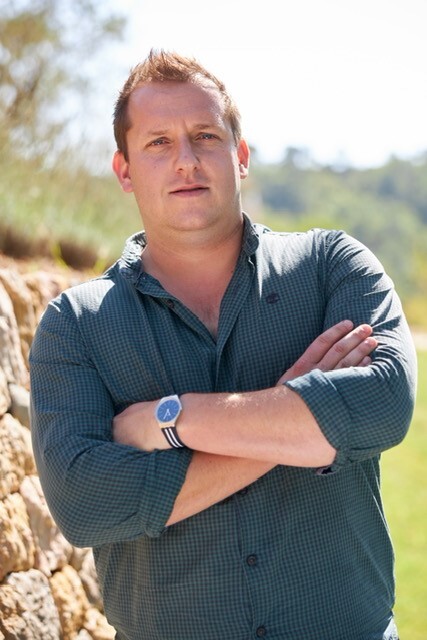
For the 16th interview in Le Figaro Vin’s series we head south down the Rhône Valley to one of its finest appellations, Châteauneuf du Pape, where we meet César Perrin, #35. Vintage after vintage he and his family devote themselves to their labours with total commitment.
An Eden in the Rhône Valley, surrounded by hills, vines, and olive trees, Château de Beaucastel is widely recognised as one of the most inspiring estates in Châteauneuf du Pape. While its origins date back to the 16th century, it was in the early 1900s that Pierre Perrin took it over. His son Jacques proved to be a true master of the winemaking craft, capable of taming the wilfulness of Grenache, while his innovative spirit led to the estate’s early adoption of biodynamic viticulture at the start of the 1970s. Today César is part of the fifth generation to carry the torch, alongside eight other members of his family, made up of his parents, uncles, brothers, and cousins. Through each successive vintage we have found ourselves utterly enchanted by the supple grace of their reds, perfectly balanced between the intensity of the fruit, the smoothness of the tannins, and an aromatic complexity which just keeps on growing deeper.
Le Figaro Vin: How does it feel to be crowned a winemaking champion?
César Perrin: I don’t think of myself as a champion. We are, more than anything, champions for our generation, continuing the achievements of our parents, grandparents, and great-grandparents before us. We have to be champions in preserving and passing on our inheritance, for we are all just passing through. It is always gratifying to know that our wines are tasted all around the world.
Have you been training for long?
Winemaking is a vocation, so we all devote a great deal of time to it, much to the detriment of our families. We train every day from a very young age. Whether in the cellar, among all the smells, or playing Le Nez du Vin and trying to recognise the fragrances, it is a little like The Drops of God. Already with my daughters, aged three and two, we taste different fruits, such as unripe cherries.
Who is your mentor?
I would say my father, who initiated us. Apart from him it would have to be my first internship supervisor, Aubert de Villaine, in 2008. He told me something that has always stuck with me: “Here at Romanée-Conti, no matter what your task is, whether it takes you an hour, or a day, or a month, you have to do it perfectly.” Ever since, I have tried to do my best on a daily basis.
Is wine a team sport?
It is for me, but most importantly wine is made to be shared and is, in that respect, a team sport. Wine is, above all, a moment for sharing, a shared emotion. You can go fast on your own, but together you go further.
What is the key to making a good wine? The terroir or the winemaker?
A great wine requires four elements: the terroir, the vine selected for planting, the climate that supports it, and the man who tends that vine. It is a combination of the four.
To what do you owe your success?
To my grandfather Jacques and my grandmother Marguerite, who turned Beaucastel into a jewel. They were pioneers, going organic in the 1950s and biodynamic in the 1970s. In rejecting the incursions of chemistry they were true visionaries.
Is your family proud of you?
I hope so. In any case, that is the great benefit of working as a family: we are very candid with each other and there is a real honesty between us. That only adds to the pressure and makes it even more imperative that we ensure our family can be proud to represent our wines.
Who is your biggest supporter?
Château de Beaucastel Châteauneuf-du-Pape Hommage à Jacques Perrin, which is our finest wine.
Your favourite colour?
Red.
Your favourite grape variety?
Mourvèdre. My grandfather was very fond of it. The grape variety was introduced to Beaucastel in the early 1930s. My grandfather went to school with Lucien Peyraud of Domaine Tempier, which is still, in my view, the greatest of the Bandols. I have noticed that the great Bandol wines were always made in the northernmost part of that appellation, while here in Châteauneuf we are at the northern boundary of our appellation. That explains why we brought Mourvèdre, which is an archetypal Bandol grape variety, to our own terroirs.
Your favourite wine?
Our whites. We have relatively very few of them, only eight to ten per cent of our production. But our Roussanne Vieilles Vignes is my favourite.
Your favourite vintage?
My first, 2012.
If your wine was a person, who would it be?
It would be a countryman.
What are the best circumstances in which to taste your wine?
With friends.
Have you ever thought about chemically enhancing yourself, or your wine?
No, quite the opposite, we have to preserve the distinctive quality of each vintage, and take what nature gives us. Nature is not always congenial, but it is what it is.
For what price would you be prepared to sell your estate?
Everything has a price, apart from family. So the question will never arise, since we want to pass it on forever.
Who is your strongest competition?
The weather.
Which competition do you dread the most?
Pruning the vines, which is such a key moment in their development.
What is your greatest trophy?
My grandmother’s pride. When she made family meals, she used to say to us: “When I am gone there is a case of wines with vintages made by me and your grandfather. I want you to open it together.” They were old magnums from 1950 and the family drank them together. It was a uniquely special experience.
What has been your most innovative strategy in the vineyard and in the cellar?
That goes back to my grandparents, with their decision to reject chemical products after the war. That has allowed us to maintain a unique ecosystem, with soils that have never been touched by chemicals.
Who would be your ideal successor on the podium?
A member of the Perrin family.
Wine Lister’s Founder and CEO, Ella Lister shares her thoughts on Bordeaux’s 2021 vintage.
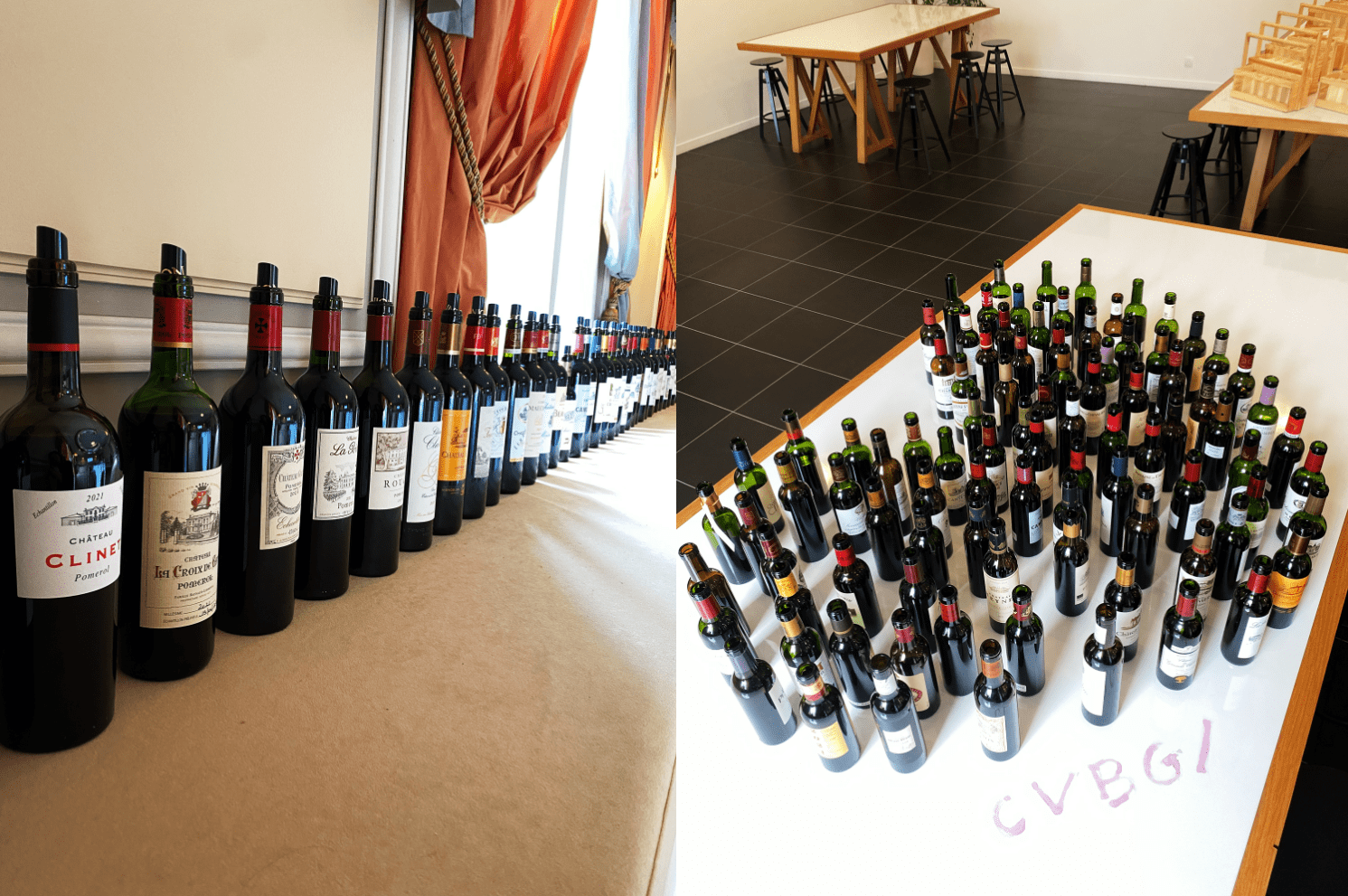 Bordeaux en primeur tastings: UGCB (left) and CVBG (right)
Bordeaux en primeur tastings: UGCB (left) and CVBG (right)
What can we expect from Bordeaux 2021?
The most complicated vintage since 2013, Bordeaux 2021 had everything thrown at it. The vines suffered a barrage of challenges during the growing season, from frost, then mildew, to a lack of the all-important hydric stress during a cool, cloudy summer. “It was a tiring vintage for us, and psychologically difficult” recalls Juliette Couderc, the new technical director at Château L’Evangile.
Bordeaux had been lucky with six relatively clement vintages in row, and en primeur tasters had been spoiled – especially with the trio of 2018, 2019, and 2020. Tasting more than 350 wines from the 2021 vintage in late April, we were reminded of en primeur tastings of old – the art of seeing through the wood, the hard tannins, the searing acidity, and attempting to form an idea of the wine’s future potential. And potential there is, if much less widespread than in the last three years. Buying decisions will need to be made carefully, and the critics’ views will be more important than in recent vintages blessed with high quality across the board.
Vinegrowing and winemaking have come on even in nine years, with know-how and tools at the disposal of producers that they didn’t necessarily have in 2013. Furthermore, 2021 had a saving grace – an unusually long growing season, beginning with early bud break, around the beginning of April, and ending with harvest dates running well into October, thanks to an Indian summer that finally provided some much-needed sunshine, with the sunniest October since 1991. Pierre-Olivier Clouet, technical director of Château Cheval Blanc, referred to a vintage “slow-cooked at a low temperature” following six years of cooking “on a high heat”.
The vintage was more challenging for merlot than for cabernet (franc or sauvignon), as the grape variety is more susceptible to mildew. Being an early ripener, merlot also missed out on the best of the Indian summer, whereas much cabernet benefitted from a warm and sunny early October, where vignerons dared to ignore the pessimistic weather forecasts for the weekend of 3rd and 4th October and hadn’t already rushed to pick before the non-existent rain. “The weather forecast was predicting an apocalypse,” recalls Vincent Millet, managing director of Château Calon-Ségur in Saint-Estèphe, but the cabernet grapes weren’t ready, so he waited, “and in the end there was no rain at all, and then a good stint of sunshine”. Further south in Margaux, Alexis Leven-Mentzelopoulos, co-owner of Château Margaux, echoes, “It was out of the question to pick unripe grapes ”.
At Château Ducru-Beaucaillou in Saint-Julien, owner Bruno Borie says the 2021 vintage is an “ode to cabernet sauvignon, which was much more resistant than merlot at every step.” However, cabernet’s upper hand in 2021 does not neatly translate into a left-bank vintage as might be expected. The right bank has its fair share of hits, and, bizarrely, fewer misses.
The watchword in 2021 is heterogeneous, and quality is undoubtedly very patchy in 2021, ranging from the seriously disappointing to the truly exceptional (though we are not in 100-point territory in this vintage). This makes it a hugely interesting en primeur campaign to taste, to sell, and to buy. It is a year where châteaux had a real opportunity to stand out from the pack, usually thanks to outstanding terroir and the application of significant resources – both financial and human. “It was viticulture seven days a week,” explains Jean-Emmanuel Danjoy, estates manager of the Château Mouton-Rothschild stable, who, like many others, underlined the vital importance of the team’s unstinting dedication. It was necessary to adapt tirelessly in the vineyard and in the winery; to accept that the fruit coming in at the end of the season wasn’t that of the three previous vintages, and be willing to throw out tried and tested recipes to make a different kind of wine, suited to the vintage. “We didn’t go looking for density that simply wasn’t there”, underlines Vincent Decup, technical director at Château Montrose in Saint-Estèphe. Down the road at Cos d’Estournel, Dominique Arangoïts points out “it’s an opportunity for wine lovers to really uncover the terroir, because the wines are stripped right back.”
The biggest challenges were to achieve a full enough body and to avoid vegetal (pyrazine) notes, without over-extracting hard, green tannins or being over-reliant on new wood, which the more delicate fruit couldn’t absorb. Many of the more successful properties used gentler extraction techniques than ever, and added a significant proportion of press wine to fill out the mid-palate. Chaptalisation was widely resorted to for the first time since 2013. The 2021 vintage nonetheless offers refreshingly modest alcohol levels – around 13% rather than the 15% or 15.5% which had become ubiquitous in recent years – potentially a key selling point with consumers.
Generalisations are not easy (or wise) in a vintage of such disparity of quality and style, but with few exceptions, the red wines tend to come in a lighter, fresher vein, recalling the classical clarets of the 1980s and 1990s. “It’s a wine style from the 80s, but with ripe grapes,” muses Aymeric de Gironde, president of Château Troplong-Mondot. The fruit is more red than black, with lots of raspberry and even some rhubarb. The vintage is less opulently floral than the last three, and floral notes are more often on a slightly more vegetal spectrum – iris, violet and lily. The worst wines have hollow mid-palates and searing acidity, and often an overdose of oak. The very best are so pure and soothing that you would never imagine the sweat and tears that went into making them. For Olivier Gautrat, maître de chai at Château L’Eglise Clinet, it was “a difficult and exhausting vintage. We’ve been out of the habit of less explosive flavour in the grapes, so we were really scared, but the more we taste, the more we find real charm in the 2021s. ”
The dry whites are pure and fresh, and the best have a sumptuous complexity. The sweet whites are remarkable, but produced in tiny quantities, if at all. For this reason Christian Seely describes Château Suduiraut 2021 as “tragically beautiful”, with yields of less than 1 hl/ha. What the reds, whites, and sweet wines all share is high acidity, which will likely result in long ageing capacity. We look forward to tasting the wines again in bottle in a couple of years to confirm that!
350+ tasting notes will be published (in French) at Le Figaro Vin next week. In the meantime, watch this space for part II of this blog series, with a focus on the Bordeaux market, to be published next week. To track the impending Bordeaux en primeur releases, click here to discover our en primeur page.
The balancing act
Following our recent report on Bordeaux’s 2021 harvest, Wine Lister now turns to Tuscany to find out more about its 2021 vintage so far, with insight from 10 top producers across the region
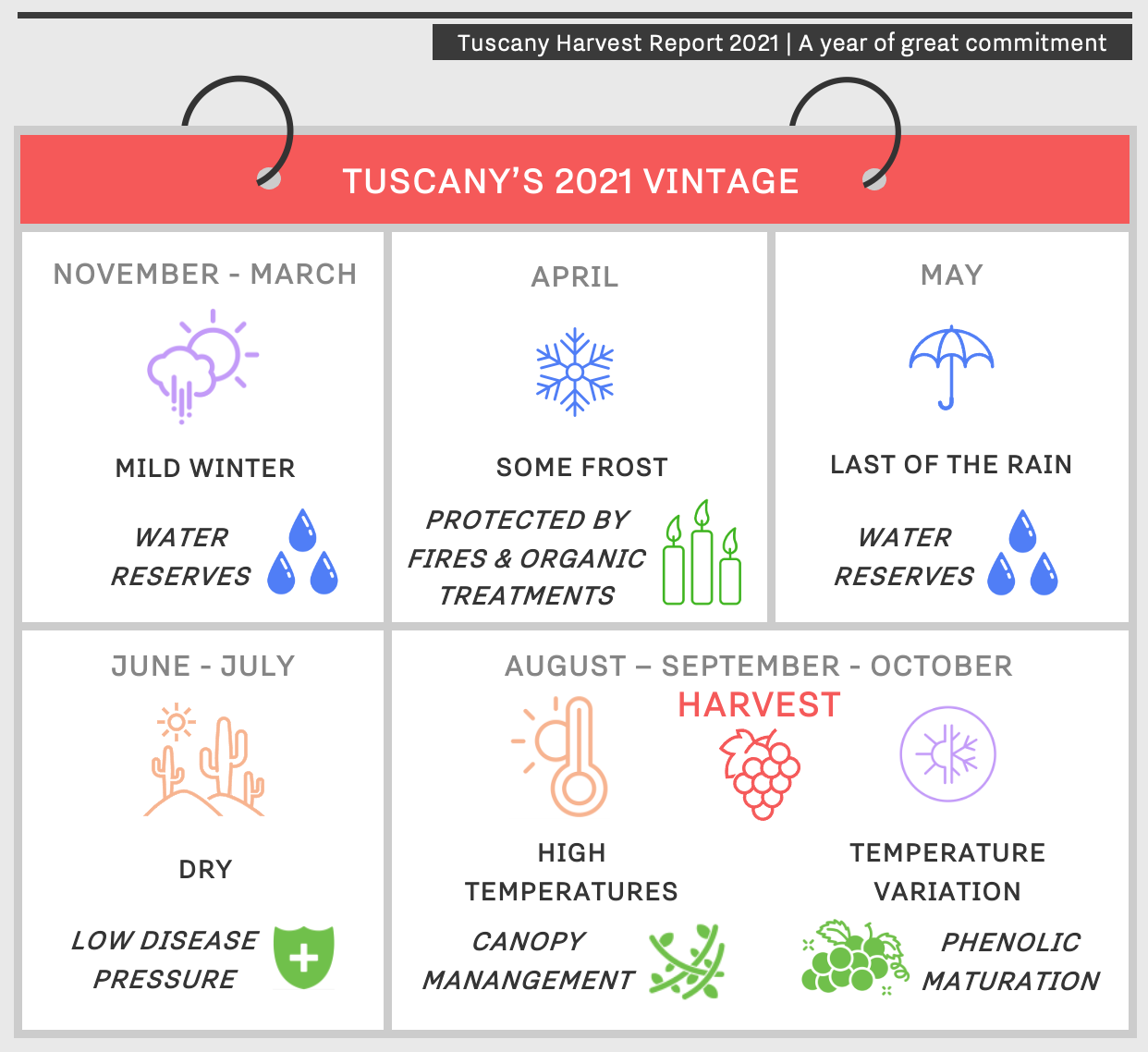
Tuscany’s 2021 growing season has been characterised as a year of climatic extremities, including a mild and rainy winter, the onset of frost in spring, persistent drought in summer, and ending in ideal harvest conditions. In a show of resilience and adaptability, producers were able to reap the benefits of acute weather patterns – with the potential consequences of drought lessened by the groundwater reserves accumulated in winter, and dry conditions reducing disease pressure over the summer.
What can we expect from Tuscany’s 2021 vintage?
Multiple methods to fight frost
- Properties lit fires in the vineyards to circulate warm air and reduce the risk of frost. Owner of IPSUS, Giovanni Mazzei tells us that the technique successfully “increased the temperature up to 2˚C” across the IPSUS vineyards, protecting the vines from damage
- Several producers used organic treatments to improve vine health following the frost, including Argiano, whose Sales Manager, Riccardo Bogi tells us that “brown algae allowed the plants to stabilise and respond as quickly as possible to the loss of sprouts”
- Frost was particularly prevalent in low-lying coastal regions, with Ornellaia’s winemaker, Axel Heinz witnessing “damages limited to a few lower altitude vineyards, without significant impact on production”. Le Macchiole’s Commercial Director, Gianluca Putzolu tells us that the estate also implemented “organic spring fertilization” to combat frost that hit “some, but fortunately very few vineyards”
Water reserves
- Rainfall during winter accumulated important water reserves at both Argiano and Romitorio, encouraging a good state of hydration ahead of the growing season
- Some high-altitude properties also saw snowfall during winter that, when melted, “percolated the soil with water”, according to Romitorio’s owner, Filippo Chia
- Abundant rainfall in May allowed plants to survive the hot summer, with Riccardo confirming that this was “essential” for Argiano’s 2021 vintage, “since after that, there was no rain until the beginning of October”. Similarly, Fèlsina’s owner, Giovanni Poggiali tells us of some “rainy days in June”
Sun and heat exposure
- “The management of the canopy needed to be delicate and precise to avoid sunburns”, explains Avignonesi’s COO and Agronomist, Alessio Gorini, who also explained that the use of high-tech sorting equipment allowed them “to completely remove any berries withered or raisined by the sun”
- Organic treatments were adopted to protect the vines from sun exposure, such as the use of “kaolin” at Tenuta San Guido. General Director, Carlo Paoli explains this to be “a natural substance that we have been using for many years in hot vintages”, which helps to reduce the vines’ susceptibility to scorching
- A broad diurnal range across several high-altitude estates encouraged balance despite the hot summer, with Castiglion del Bosco’s winemaker, Cecilia Leoneschi noting that the difference of more than 10°C between day and night temperatures was a “real blessing”
 Teamwork amongst Tuscan vines: IPSUS (left), Tenuta San Guido (middle), Ornellaia (right)
Teamwork amongst Tuscan vines: IPSUS (left), Tenuta San Guido (middle), Ornellaia (right)
A remarkably healthy vintage
- Lack of rain throughout June and July minimised disease pressure; Filippo confirmed that “from a mould and disease standpoint, it was actually one of the healthiest vintages [Romitorio] has seen”, thanks to the “dry summer”. Giovanni echoes this sentiment for IPSUS, while Gianluca reiterates there were “no particular problems” at Le Macchiole, despite the risk of powdery mildew – a more common problem for the Bolgheri area
Striking when the time was right
- For many estates, harvest timing was essential, with Alessio and the Avignonesi team similarly conscious of “avoiding over-ripening on such concentrated grapes”
- Producers had to be particularly reactive to picking dates, explains Axel – whose 2021 harvest “required great skill” in planning, eventually leading to a “very compact harvest completed in one month, instead of the usual 40 days”. Owner of Tua Rita, Giovanni Frascolla similarly characterised 2021 as a “lightning harvest”
Balanced acidity
- “Powerful dark structure – we normally see this with low acid, but this has high acid” recounts Filippo from Romitorio’s latest tasting of the blend
- First impressions show “bright aromatics and, luckily high acidities to keep everything in balance”, at Ornellaia, with Axel describing a “rich and concentrated” wine, “with soft tannins”
- “Grapes matured in a homogeneous way and with a perfect balance of acidity and PH” explains Carlo at Tenuta San Guido
Working around the clock
Wine Lister catches up with nine top producers from Bordeaux’s Left Bank to find out more about their 2021 harvest, and to hear their early evaluation of the vintage
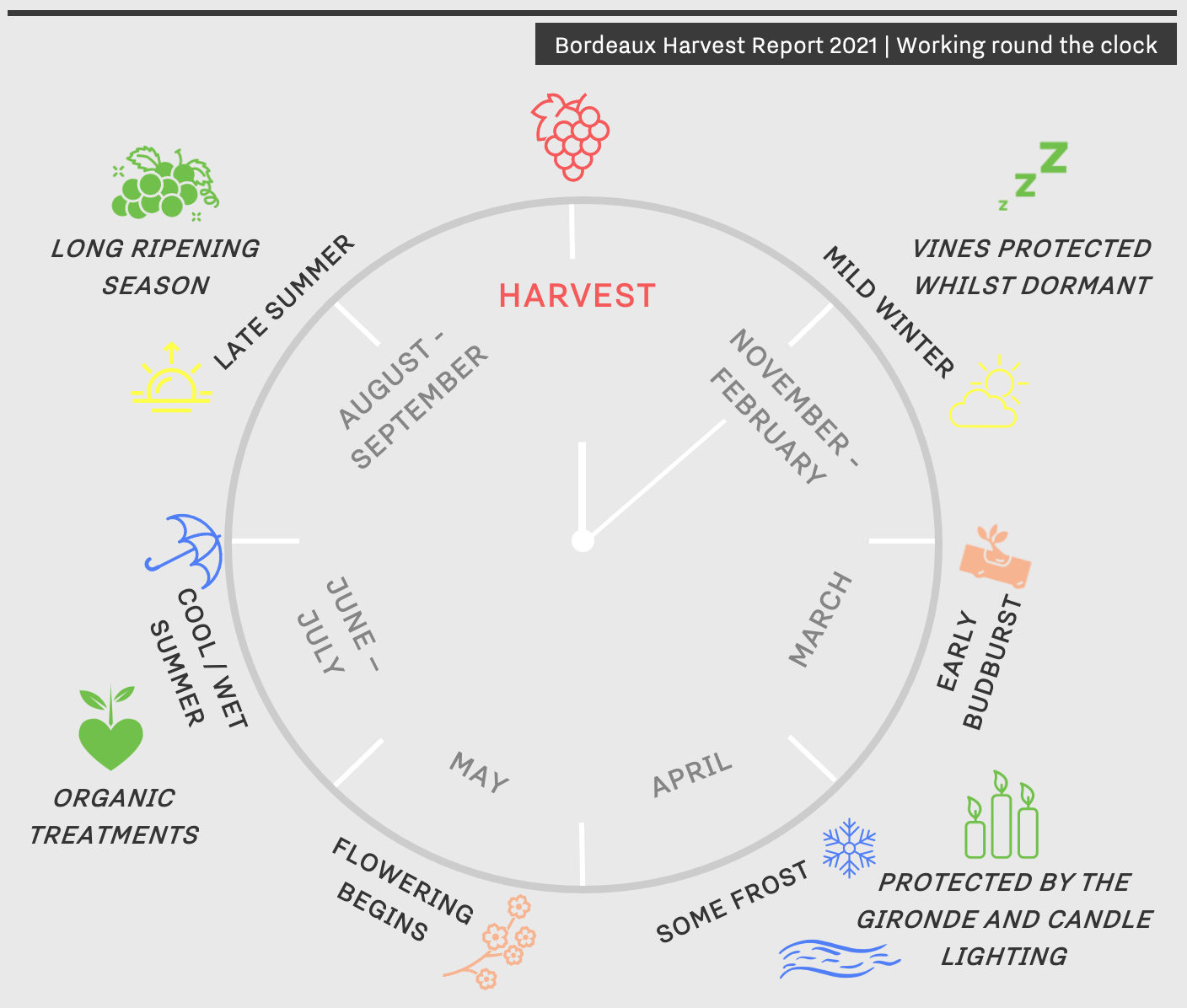
Bordeaux’s 2021 vintage required patience and commitment. Producers worked around the clock to protect their vines – some were threatened by frost, others by disease pressure over the cool and wet summer, but all brought their respective teams together, facing the hand that Mother Nature dealt them with the best experience and techniques the modern wine world has to offer.
What do we know about Bordeaux’s 2021 vintage so far?
Frost protection
- Several producers were protected from the April frost due to their proximity to rivers – just 600m from its banks of the Gironde, d’Issan vineyards escaped damage, according to owner, Emmanuel Cruse. Similarly, Vineyard Manager, Nicolas Dudebout tells us that Malescasse were “naturally shielded” by their privileged positioning near the Garonne
- Other properties were well-equipped to fight the frost proactively, with Smith Haut-Lafitte’s owner Florence Cathiard confirming that a combination of “Valerian decoction (Valeriana officinalis plant root used for its restorative properties), and candles” protected their vines
Organics against disease pressure
- The cool and wet start to summer left some producers vulnerable to disease pressure: Florence told us that Smith Haut-Lafitte reacted to the threat of mildew using “copper mixed with phytotherapy decoctions of horsetail, nettle, wicker, and comfrey”
- “We take the best of both worlds” at Larrivet Haut-Brion, describes Cellar Master, Charlotte Mignon. She explains that the team were “reactive to fighting mildew attacks”, using biocontrol to facilitate the sustainable use of “organic, biodynamic, and conventional solutions [as] necessary”
Late summer ripening
- Late summer sun in August and September created favourable conditions for Merlot, an early-ripening grape variety that is notoriously challenging in hotter temperatures. Cos d’Estournel’s Technical Director, Dominique Arangoïts, found their Merlot to be “remarkably enticing, fruity, and rich with a very noble expression”
- Slower ripening of Cabernet Sauvignon grapes encouraged good phenological maturity: During his last harvest at Lafon-Rochet, Basile Tesseron tells us that, following early pre-harvest berry tastings, the grapes fortunately progressed beautifully in the last few weeks, eventually becoming “more expressive, and well-balanced”
- After a trio of warmer vintages, Charlotte notes that the Cabernets at Larrivet Haut-Brion achieved “perfect ripeness”, thanks to a longer growing season, and sunshine in late-August right up until harvest in October, which gave grapes with “a very good state of health”
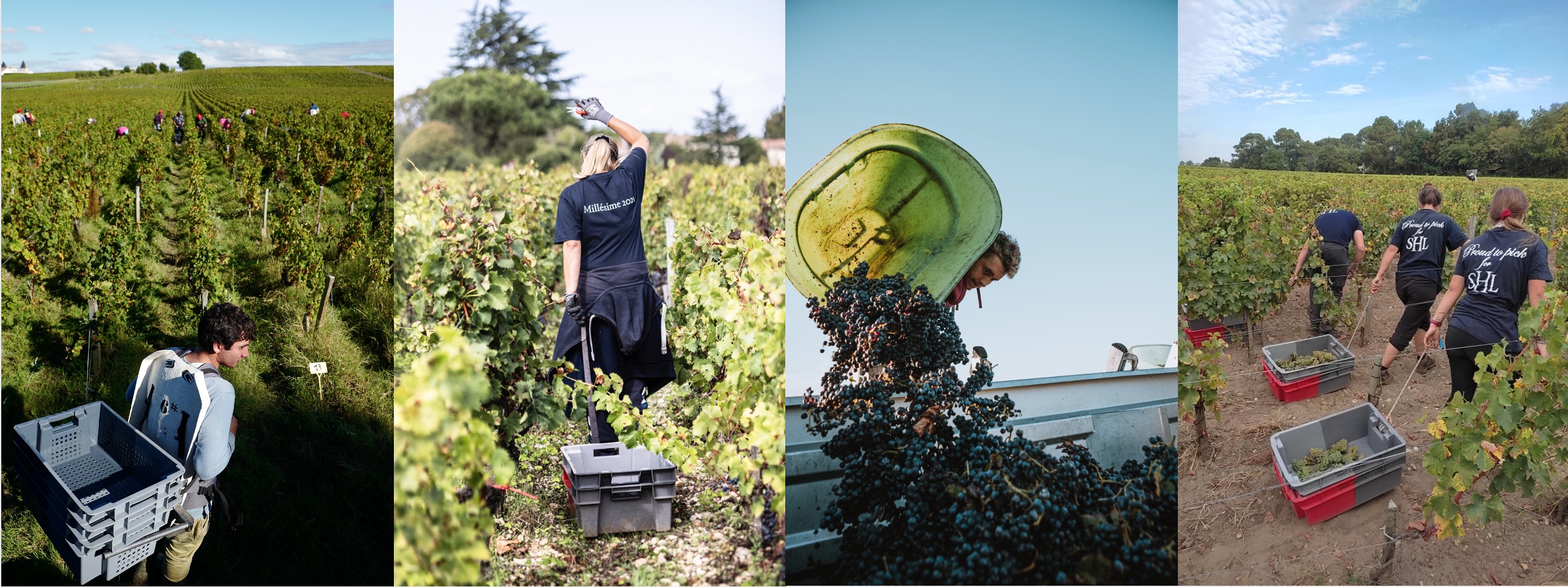 A snapshot of this year’s harvest: Lafon-Rochet (far left), Palmer (middle left), d’Issan (middle right), and Smith Haut-Lafitte (far right)
A snapshot of this year’s harvest: Lafon-Rochet (far left), Palmer (middle left), d’Issan (middle right), and Smith Haut-Lafitte (far right)
Lower alcohol content
- “Low levels of sugar have resulted in a lower alcohol content” in Cos d’Estournel’s Cabernet Sauvignon this year, with Dominique identifying “a magnificent intensity and freshness” and the characteristics of “the most elegant, sophisticated wines”
- “This harvest will be marked by an alcohol-acidity balance, completely different from previous years”, observes Haut-Brion’s Technical Director, Jean-Philippe Masclef. Their Cellar Master, Florence Forgas associates “moderate alcoholic degrees” as being “closer to much older vintages”
- A cooler vintage compared to the previous three resulted in “pure fruit, and a very interesting density” in Palmer’s 2021 grapes, according to Thomas Duroux
Good things to come
- “Merlots are softer than usual and the Cabernets more compact” according to Cantenac Brown’s winemaker José Sanfins, who hopes for an overall blend that is “dense and complete, with fine and elegant tannins”
- Favourable weather during harvest, including “morning temperatures of around 4˚C, preserving freshness across all grape varieties” at d’Issan
- Bordeaux’s whites also boast vibrancy in 2021, with Charlotte noting “freshness and tension” with “aromatic clarity” from Larrivet Haut-Brion’s Sauvignon Blanc and Sémillon grapes
Margaux’s Wine of the Vintage?
Our latest article takes a closer look at one of the final entries in the Place de Bordeaux’s September 2021 Campaign, as we examine Palmer’s re-release from one of Bordeaux’s most challenging recent vintages.
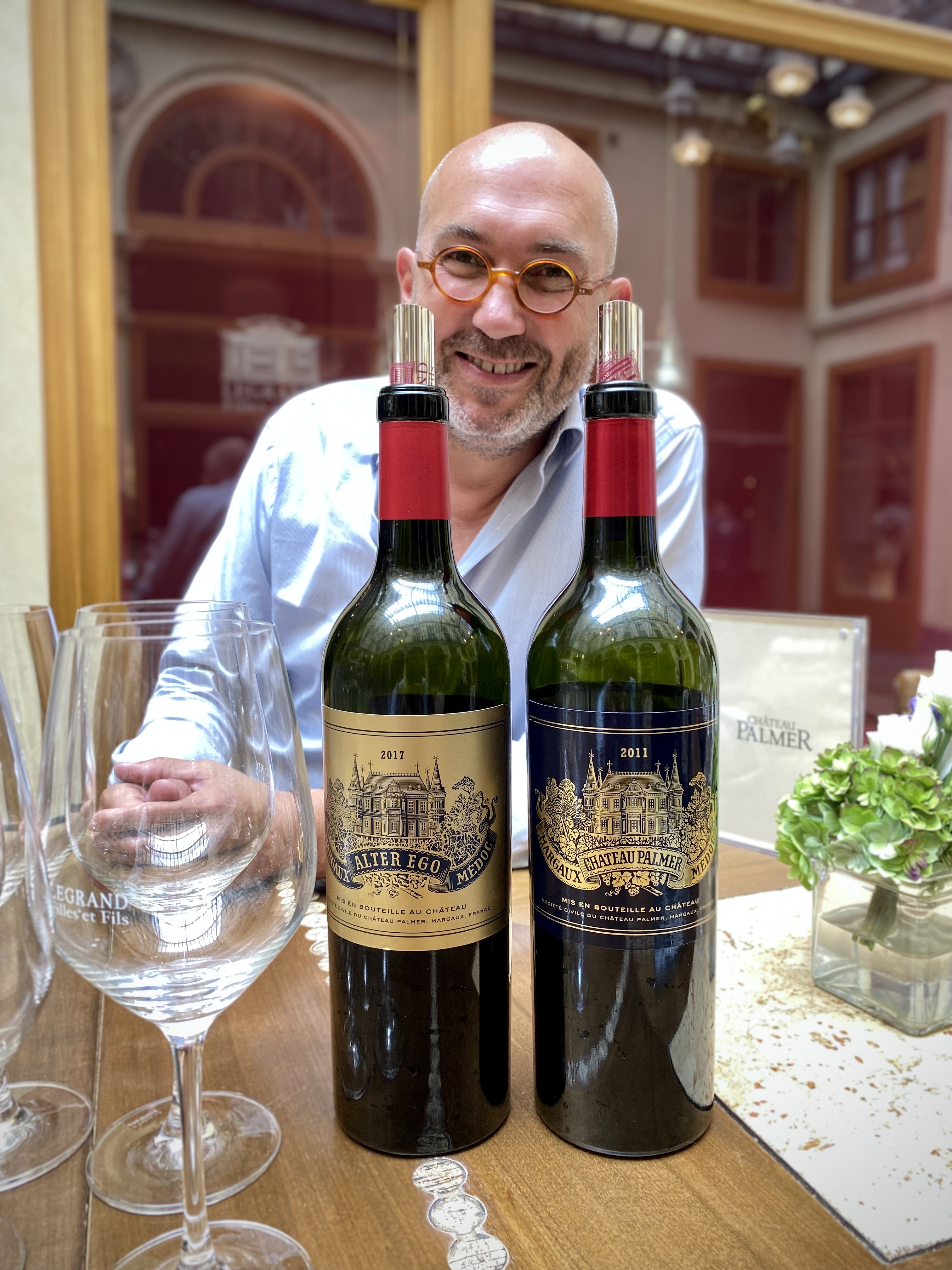 Palmer’s Director, Thomas Duroux tasting Palmer 2011 and Alter Ego 2017 with Wine Lister CEO, Ella Lister
Palmer’s Director, Thomas Duroux tasting Palmer 2011 and Alter Ego 2017 with Wine Lister CEO, Ella Lister
What is the story behind Palmer’s 2011 vintage?
Palmer’s precious secrets
A decade on from production, Thursday 23rd September saw the re-release of Palmer 2011 with a recommended UK onward selling price of £228 per bottle (in-bond). This release represents the second instalment of their ‘10 years on’ series, which presents decade-old ex-château stocks to the market via the Place de Bordeaux. While still releasing Palmer’s latest vintages en primeur, the estate’s Director, Thomas Duroux tells Wine Lister CEO, Ella Lister that withholding stock for ex-château release for 10 years plays tribute to Émile Peynaud’s philosophy that “A great wine needed at latest 10 years of age before it was ready to drink”.
The story of a peculiar vintage
Building momentum amongst merchants and collectors for the release of a notoriously challenging vintage is no mean feat. Duroux’s deft storytelling played on the strengths of Palmer’s historically low yields, reminiscing the events of this curious vintage to encourage interest in the re-release. With a mere 20 hl, the 2011 produced less than half the yield of a normal year, and the even-greater scarcity of re-release availability (approximately 1,000 cases) was surely designed to entice further demand. Several Bordeaux properties suffered at the hands of a significant hailstorm on 4th June 2011, with some falling victim to damage in the crucial berry set period. Although Palmer felt the effects of the growing season, it nonetheless still produced a well-scored wine, matching the average WL score of first growths Margaux, Lafite, and Mouton (93).
Crunch time
Duroux links the quality of their 2011 to the somewhat merciful timing of the hailstorm. Having passed through flowering, the berries were small and able to withstand the storm’s impact, with the damage sustained mostly by the vine’s young shoots. Since the vines compensated by rerouting their energy to grow new shoots, they devoted less energy to fruit development, therefore the harvest yielded a smaller collection of concentrated berries. Such details serve as a good reminder, that the story of a vintage can only paint a partial (and general) picture – digging into the detail of each estate can uncover so much more potential.








 Teamwork amongst Tuscan vines: IPSUS (left), Tenuta San Guido (middle), Ornellaia (right)
Teamwork amongst Tuscan vines: IPSUS (left), Tenuta San Guido (middle), Ornellaia (right)
 A snapshot of this year’s harvest: Lafon-Rochet (far left), Palmer (middle left), d’Issan (middle right), and Smith Haut-Lafitte (far right)
A snapshot of this year’s harvest: Lafon-Rochet (far left), Palmer (middle left), d’Issan (middle right), and Smith Haut-Lafitte (far right) Palmer’s Director, Thomas Duroux tasting
Palmer’s Director, Thomas Duroux tasting